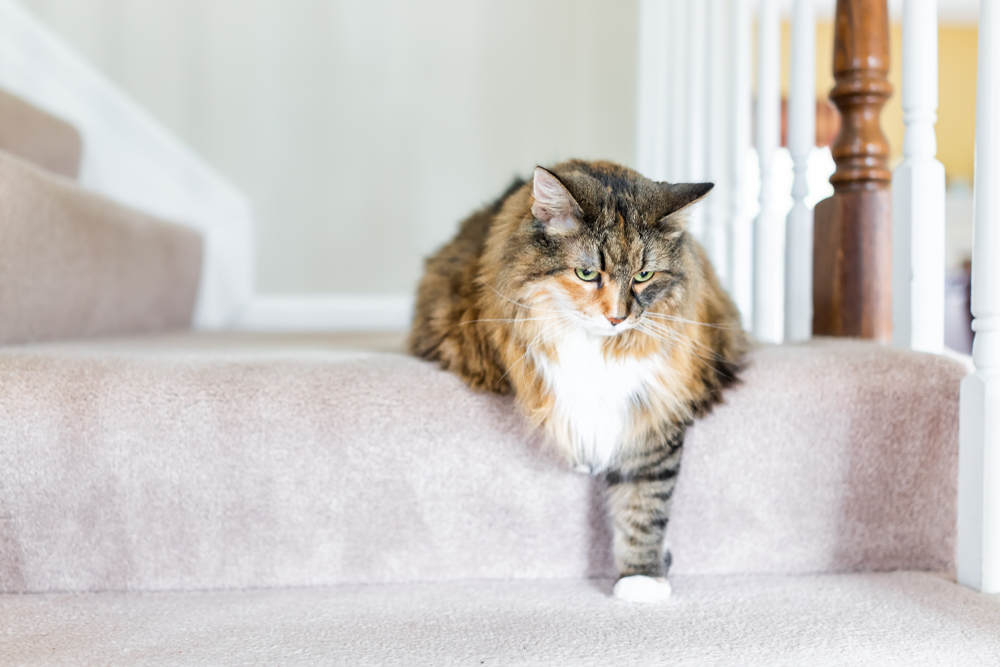Your feline friend is skilled at many things—waking you up at 3 a.m. for more food, finding the most comfortable spot on your lap, and leveling you with a hard stare when you stop scratching under their chin. However, your cat is also exceedingly talented at hiding signs of illness and pain. Arthritis is one of cats’ most common health issues—and one of the most difficult to detect. Learn how to spot this condition to help improve your cat’s joint health and comfort.
What is arthritis in cats?
Simply put, arthritis is joint inflammation. This chronic condition causes ongoing pain for pets, and worsens as joint cartilage degenerates. Without the protective cartilage cushion between bones, the bones rub against each other, causing pain and decreased mobility.
What causes arthritis in cats?
Arthritis in cats has several causes. Outside of normal wear-and-tear, certain factors can increase your feline friend’s risk for developing arthritis:
- Genetics — Certain breeds have an increased risk because of underlying joint problems, such as hip dysplasia, luxating patellas, and cartilage abnormalities. Maine Coon, Persian, Siamese, Abyssinian, Devon Rex, and Scottish Fold cats are most likely to be affected.
- Age — While young cats can develop arthritis, this joint condition is much more common in senior cats, particularly those over 12 years of age.
- Obesity — Not only is obesity an inflammatory condition, it also creates more pressure on a cat’s already stressed joints.
- Physical trauma — Fractures, dislocations, ligament tears, and other joint injuries can cause abnormal joint conformation and subsequent arthritis.
What are arthritis signs in cats?
Unlike other animals, cats rarely exhibit the limping and lameness that are commonly associated with arthritis. Instead, you may notice the following signs:
- Reduced mobility
- Reluctance to jump
- Difficulty going up or down stairs
- Stiffness, especially after sleeping
- Difficulty using the litter box
- Reduced activity
- Increased sleeping
- Reduced interaction
- Reduced grooming, resulting in a matted coat
- Overgrooming of painful joints
- Overgrown claws due to lack of activity and reduced sharpening of claws
- Increased irritability when handled and petted
- Avoidance of other pets and people
These signs can be subtle and difficult to detect, so keep a close eye on your cat for behavior changes. Inappropriate elimination, a decreased appetite, an unkempt coat, and obvious discomfort when petted are key arthritis signs.

How is feline arthritis diagnosed?
An arthritis diagnosis is often reached after discussing the changes you see in your cat at home and the changes detected on a physical exam. Our Driftwood Animal Hospital veterinarian may be able to spot joint pain, swelling, or reduced mobility. X-rays of the suspect joints may help provide a definitive diagnosis. In some cases, blood work may be warranted to rule out other causes. Blood work is also necessary before placing your cat on a long-term medication designed to reduce inflammation and pain because these drugs can adversely affect the kidneys.
How is feline arthritis managed?
Although feline arthritis is a chronic condition that will continue to worsen, there are numerous ways to manage your cat’s pain and slow the disease’s progression.
- Environmental modification — With a cat’s desire to reach lofty spots, modifying their environment so they can comfortably access a lookout perch is important. Place ramps that lead up to your cat’s favorite resting place, such as a windowsill or the top of a climbing tower. Invest in short-sided litter boxes and place them in easily accessible areas, ensuring one is available on each floor of your home. Food and water bowls may need to be elevated so your cat does not have to bend down on painful elbows.
- Diet — Since cats are more likely to be overweight than not, a properly portioned diet is essential for reducing their weight. If you are struggling to help your cat reach their goal weight, ask our team about a prescription diet. Several options exist that provide weight loss and joint health benefits. Additionally, joint health supplements, especially when begun early in the disease process, can preserve your cat’s joint cartilage and reduce inflammation.
- Pharmaceutical treatment — A variety of medications are available that can alleviate your cat’s joint pain and inflammation. Nonsteroidal anti-inflammatories (NSAIDs) are often the first line of defense, but they can have unwanted side effects, especially in cats with chronic kidney disease. Medications outside the NSAID class also can reduce your cat’s pain, with less harm to the kidneys.
- Alternative therapies — If your cat is not an ideal candidate for medication, alternative therapies can still effectively manage their pain and improve mobility. These therapies also round out a multimodal treatment plan, providing maximum benefits. Consider acupuncture, laser therapy, hydrotherapy, physical therapy, and other alternative treatments to reduce pain and inflammation.
Cats are masters at hiding signs of pain associated with arthritis, but the condition can be identified by discussing changes you have seen in your cat with your Driftwood Animal Hospital veterinarian. Contact our team to schedule an orthopedic evaluation for your pet.








Leave A Comment